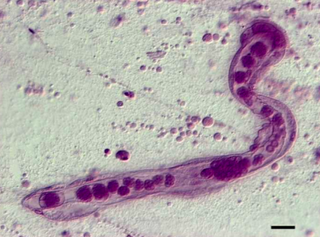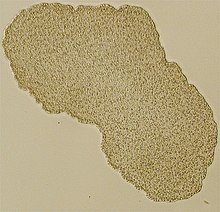In biology, taxonomy is the scientific study of naming, defining (circumscribing) and classifying groups of biological organisms based on shared characteristics. Organisms are grouped into taxa and these groups are given a taxonomic rank; groups of a given rank can be aggregated to form a more inclusive group of higher rank, thus creating a taxonomic hierarchy. The principal ranks in modern use are domain, kingdom, phylum, class, order, family, genus, and species. The Swedish botanist Carl Linnaeus is regarded as the founder of the current system of taxonomy, as he developed a ranked system known as Linnaean taxonomy for categorizing organisms and binomial nomenclature for naming organisms.

The Mesozoa are minuscule, worm-like parasites of marine invertebrates. Generally, these tiny, elusive creatures consist of a somatoderm of ciliated cells surrounding one or more reproductive cells.
In biology, a kingdom is the second highest taxonomic rank, just below domain. Kingdoms are divided into smaller groups called phyla.
Order is one of the eight major hierarchical taxonomic ranks in Linnaean taxonomy. It is classified between family and class. In biological classification, the order is a taxonomic rank used in the classification of organisms and recognized by the nomenclature codes. An immediately higher rank, superorder, is sometimes added directly above order, with suborder directly beneath order. An order can also be defined as a group of related families.

Carbondale is a city in Jackson County, Illinois, United States, within the Southern Illinois region informally known as "Little Egypt". The city developed from 1853 because of the stimulation of railroad construction into the area. Today, the major roadways of Illinois Route 13 and U.S. Route 51 intersect in the city. The city is 96 miles (154 km) southeast of St. Louis, on the northern edge of the Shawnee National Forest. Carbondale is the home of the main campus of Southern Illinois University (SIU).

Parazoa are a taxon with sub-kingdom category that is located at the base of the phylogenetic tree of the animal kingdom in opposition to the sub-kingdom Eumetazoa; they group together the most primitive forms, characterized by not having proper tissues or that, in any case, these tissues are only partially differentiated. They generally group a single phylum, Porifera, which lack muscles, nerves and internal organs, which in many cases resembles a cell colony rather than a multicellular organism itself. All other animals are eumetazoans, which do have differentiated tissues.

Eumetazoa, also known as diploblasts, Epitheliozoa, or Histozoa, are a proposed basal animal clade as a sister group of the Porifera (sponges). The basal eumetazoan clades are the Ctenophora and the ParaHoxozoa. Placozoa is now also seen as a eumetazoan in the ParaHoxozoa. The competing hypothesis is the Myriazoa clade.

Orthonectida is a small phylum of poorly known parasites of marine invertebrates that are among the simplest of multi-cellular organisms. Members of this phylum are known as orthonectids.

Southern Illinois University is a public research university in Carbondale, Illinois. Chartered in 1869, SIU is the oldest and flagship campus of the Southern Illinois University system. Originally founded as a normal college, the university today provides programs in a variety of disciplines, combining a strong liberal arts tradition with a focus on research. SIU was granted limited university status in 1943 and began offering graduate degrees in 1950. A separate campus was established in Edwardsville, Illinois in 1957, eventually becoming Southern Illinois University Edwardsville.

Thomas (Tom) Cavalier-Smith, FRS, FRSC, NERC Professorial Fellow, was a professor of evolutionary biology in the Department of Zoology, at the University of Oxford.

Dicyemida, also known as Rhombozoa, is a phylum of tiny parasites that live in the renal appendages of cephalopods.
Richard Eliot Blackwelder was an American biologist, professor and author specializing in entomology and taxonomy. After a distinguished professional career, he retired in 1977, and in 1978 he discovered the works of J. R. R. Tolkien, which were to be the focus of his energies for the remainder of his life. Over the next twenty years, Blackwelder amassed a large collection of Tolkien-related books and other materials, which he sorted and indexed. The Blackwelder Collection, donated to Marquette University in 1982, is believed to be the largest single body of secondary sources on Tolkien ever to be developed.
The following outline is provided as an overview of and topical guide to zoology:

Metro Lakeland is a name that was coined in the 1960s for an area of southern Illinois that is centered on the intersections of Interstate 57, Interstate 24, and Illinois Route 13 — a four-lane east-west highway connecting the communities of Murphysboro, Carbondale, Carterville, Herrin, Marion, and Harrisburg. Metro Lakeland was defined as Jackson, Williamson, Franklin, Saline, and Perry counties, with a combined population of approximately 210,000. Carbondale, Herrin, and Marion are the key urban areas, with a combined city-proper population of over 65,000 Carbondale, the site of Southern Illinois University, is the region's largest city. Metro Lakeland is about 88 miles (142 km) southeast of St. Louis, Missouri, or 120 miles (190 km) by Interstate highway.

Monera is historically a biological kingdom that is made up of prokaryotes. As such, it is composed of single-celled organisms that lack a nucleus. It has been superseded by the three-domain system.

Protozoa are a polyphyletic group of single-celled eukaryotes, either free-living or parasitic, that feed on organic matter such as other microorganisms or organic debris. Historically, protozoans were regarded as "one-celled animals", because they often possess animal-like behaviours, such as motility and predation, and lack a cell wall, as found in plants and many algae.
In biology, a phylum is a level of classification or taxonomic rank below kingdom and above class. Traditionally, in botany the term division has been used instead of phylum, although the International Code of Nomenclature for algae, fungi, and plants accepts the terms as equivalent. Depending on definitions, the animal kingdom Animalia contains about 31 phyla, the plant kingdom Plantae contains about 14 phyla, and the fungus kingdom Fungi contains about 8 phyla. Current research in phylogenetics is uncovering the relationships between phyla, which are contained in larger clades, like Ecdysozoa and Embryophyta.
A life form is an entity that is living, such as plants (flora), animals (fauna), and fungi (funga). It is estimated that more than 99% of all species that ever existed on Earth, amounting to over five billion species, are extinct.
The initial version of a classification system of life by British zoologist Thomas Cavalier-Smith appeared in 1978. This initial system continued to be modified in subsequent versions that were published until he died in 2021. As with classifications of others, such as Carl Linnaeus, Ernst Haeckel, Robert Whittaker, and Carl Woese, Cavalier-Smith's classification attempts to incorporate the latest developments in taxonomy., Cavalier-Smith used his classifications to convey his opinions about the evolutionary relationships among various organisms, principally microbial. His classifications complemented his ideas communicated in scientific publications, talks, and diagrams. Different iterations might have a wider or narrow scope, include different groupings, provide greater or lesser detail, and place groups in different arrangements as his thinking changed. His classifications has been a major influence in the modern taxonomy, particularly of protists.
Robert H. Mohlenbrock is an American botanist and author. Mohlenbrock is an authority on the plants of Illinois, with expertise in floristics, plant taxonomy, endangered species, and wetland flora.











